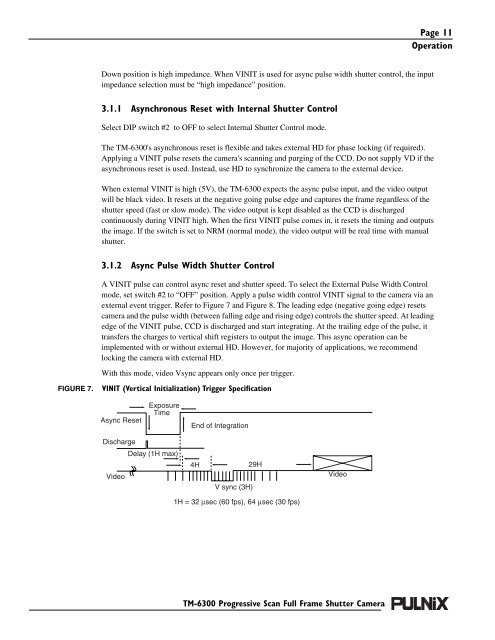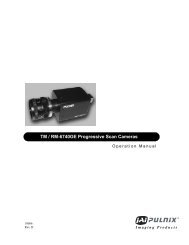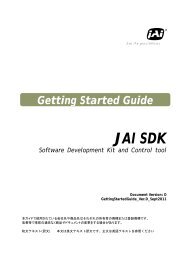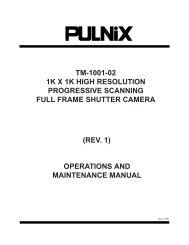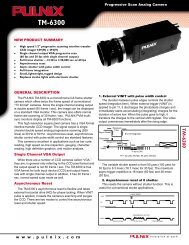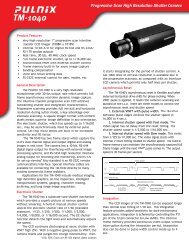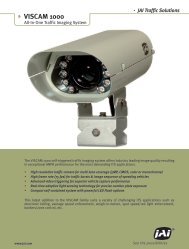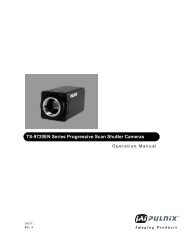User manual (PDF) - JAI Pulnix
User manual (PDF) - JAI Pulnix
User manual (PDF) - JAI Pulnix
You also want an ePaper? Increase the reach of your titles
YUMPU automatically turns print PDFs into web optimized ePapers that Google loves.
Page 11<br />
Operation<br />
Down position is high impedance. When VINIT is used for async pulse width shutter control, the input<br />
impedance selection must be “high impedance” position.<br />
3.1.1 Asynchronous Reset with Internal Shutter Control<br />
Select DIP switch #2 to OFF to select Internal Shutter Control mode.<br />
The TM-6300's asynchronous reset is flexible and takes external HD for phase locking (if required).<br />
Applying a VINIT pulse resets the camera's scanning and purging of the CCD. Do not supply VD if the<br />
asynchronous reset is used. Instead, use HD to synchronize the camera to the external device.<br />
When external VINIT is high (5V), the TM-6300 expects the async pulse input, and the video output<br />
will be black video. It resets at the negative going pulse edge and captures the frame regardless of the<br />
shutter speed (fast or slow mode). The video output is kept disabled as the CCD is discharged<br />
continuously during VINIT high. When the first VINIT pulse comes in, it resets the timing and outputs<br />
the image. If the switch is set to NRM (normal mode), the video output will be real time with <strong>manual</strong><br />
shutter.<br />
3.1.2 Async Pulse Width Shutter Control<br />
A VINIT pulse can control async reset and shutter speed. To select the External Pulse Width Control<br />
mode, set switch #2 to “OFF” position. Apply a pulse width control VINIT signal to the camera via an<br />
external event trigger. Refer to Figure 7 and Figure 8. The leading edge (negative going edge) resets<br />
camera and the pulse width (between falling edge and rising edge) controls the shutter speed. At leading<br />
edge of the VINIT pulse, CCD is discharged and start integrating. At the trailing edge of the pulse, it<br />
transfers the charges to vertical shift registers to output the image. This async operation can be<br />
implemented with or without external HD. However, for majority of applications, we recommend<br />
locking the camera with external HD.<br />
With this mode, video Vsync appears only once per trigger.<br />
FIGURE 7.<br />
VINIT (Vertical Initialization) Trigger Specification<br />
Async Reset<br />
Exposure<br />
Time<br />
End of Integration<br />
Discharge<br />
Video<br />
Delay (1H max)<br />
4H<br />
V sync (3H)<br />
29H<br />
Video<br />
1H = 32 µsec (60 fps), 64 µsec (30 fps)<br />
TM-6300 Progressive Scan Full Frame Shutter Camera


